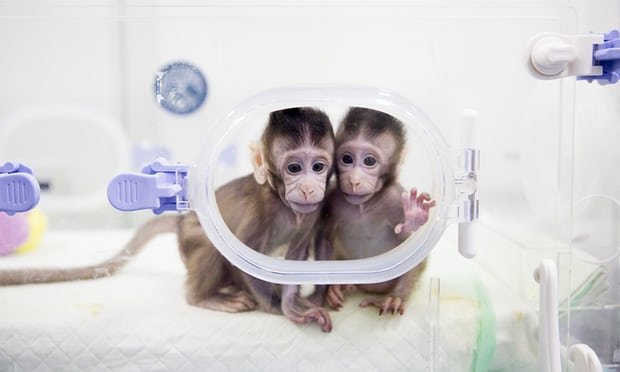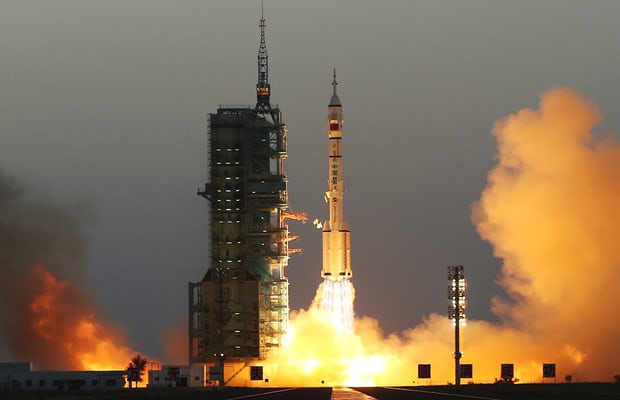China’s great leap forward in science
China’s great leap forward in science
Chinese investment is paying off with serious advances in biotech, computing and space. Are they edging ahead of the west?

I first met Xiaogang Peng in the summer of 1992 at Jilin University in Changchun, in the remote north-east of China, where he was a postgraduate student in the department of chemistry. He told me that his dream was to get a place at a top American lab. Now, Xiaogang was evidently smart and hard-working – but so, as far as I could see, were most Chinese science students. I wished him well, but couldn’t help thinking he’d set himself a massive challenge.
Fast forward four years to when, as an editor at Nature, I publish a paper on nanotechnology from world-leading chemists at the University of California at Berkeley. Among them was Xiaogang. That 1996 paper now appears in a 10-volume compendium of the all-time best of Nature papers being published in translation in China.
I watched Xiaogang go on to forge a solid career in the US, as in 2005 he became a tenured professor at the University of Arkansas. But when I recently had reason to get in touch with Xiaogang again, I discovered that he had moved back to China and is now at Zhejiang University in Hangzhou – one of the country’s foremost academic institutions.
For Xiaogang, it seems that America was no longer the only land of opportunity. These days, Chinese scientists stand at least as good a chance of making a global impact on science from within China itself.
The economic rise of China has been accompanied by a waxing of its scientific prowess. In January, the United States National Science Foundation reported that the number of scientific publications from China in 2016 outnumbered those from the US for the first time: 426,000 versus 409,000. Sceptics might say that it’s about quality, not quantity. But the patronising old idea that China, like the rest of east Asia, can imitate but not innovate is certainly false now. In several scientific fields, China is starting to set the pace for others to follow. On my tour of Chinese labs in 1992, only those I saw at the flagship Peking University looked comparable to what you might find at a good university in the west. Today the resources available to China’s top scientists are enviable to many of their western counterparts. Whereas once the best Chinese scientists would pack their bags for greener pastures abroad, today it’s common for Chinese postdoctoral researchers to get experience in a leading lab in the west and then head home where the Chinese government will help them set up a lab that will eclipse their western competitors.
There is always a certain fraction of talented, innovative people. China has the advantage of having lots of people
Many have been lured back by the Thousand Talents Plan, in which scientists aged under 55 (whether Chinese citizens or not) are given full-time positions at prestigious universities and institutes, with larger than normal salaries and resources. “Deng Xiaoping sent many Chinese students and scholars out of China to developed countries 30 to 40 years ago, and now it is time for them to come back,” says George Fu Gao of the Institute of Microbiology of the Chinese Academy of Sciences in Beijing – who himself gained a PhD at Oxford before studying at Harvard.
“The startup packages for researchers in good universities in China can be significantly higher than Hong Kong universities can offer,” says Che Ting Chan, a physicist at the Hong Kong University of Science & Technology in what was previously China’s affluent and westernised neighbour. “They provide more lab space and can help settle the spouse.” That, he notes ruefully, “makes recruiting young faculty staff increasingly challenging here.” Other well-off east Asian countries, such as Singapore and South Korea, are feeling the competition too.
The Chinese authorities are pursuing scientific dominance with systematic resolve. The annual expenditure on research and development in China increased from 1995 to 2013 by a factor of more than 30, and reached $234bn in 2016. The number of international publications coming out of China has remained in step with this rise. “Money is plentiful to certain Chinese researchers, possibly more so than to their competitors, especially if it means gaining an edge,” says stem-cell biologist Robin Lovell-Badge of the Francis Crick Institute in London.
The ultimate aim is to develop a homegrown, innovative research environment, says Mu-Ming Poo of the Institute of Neuroscience of the Chinese Academy of Sciences in Shanghai. “The government is beginning to recognise that big investment and recruitment of talent from abroad are not sufficient. We need to build infrastructure and mechanisms that facilitate innovation within China.” That’s not easy, and won’t happen fast. “Officially, government leaders say that taking risks is allowed, but the system of evaluating scientists and projects, and the philosophy and methods of instruction in university curricula, aren’t compatible with this policy.”
China’s moon mission to boldly go a step further
Read more
China’s strength also comes down to sheer numbers, though. “There is always a certain fraction of talented people who are innovative,” says Chan. “China has the advantage of having a lot of people.”
One of the more controversial ways Chinese institutions encourage their researchers to publish high-profile papers is to offer cash incentives. One study found that on average a paper in Nature or Science could earn the author a bonus of almost $44,000 in 2016. The highest prize on offer was as much as $165,000 for a single paper, up to 20 times a typical university professor’s annual salary.
According to quantum physicist Jian-Wei Pan of the University of Science and Technology in Hefei, as a relative latecomer to the global scientific stage, China needs such incentives as a way of maintaining enthusiasm. Chan adds that “the rewarding system is transparent, and the expectation of the senior administration is clearly spelled out. Most of my friends in China don’t see this as a problem – many feel that any formula, even if it’s simple and naive, is better than no formula.”
But could it not tempt researchers to cheat – fabricate or cherrypick results so that they can claim a dramatic discovery? The 2016 study of cash incentives also reported a rise in plagiarism, ghostwritten papers and other dishonest attempts to get published. Poo says that, whatever the case, the practice of cash incentives is not widespread. “Only a few low-level research institutions are doing this, not the Chinese Academy of Sciences or top universities,” he says. He thinks that problems with scientific misconduct and fraud in China have more to do with poor quality control or lack of punitive measures.
However, the pattern seems clear, and is worth heeding by other nations: despite China’s reputation for authoritarian and hierarchical rule, in science the approach seems to be to ensure that top researchers are well supported with funding and resources, and then to leave them to get on with it.

two cloned baby macaques in an incubator or transparent cage in china january 2018
Facebook Twitter Pinterest
Pair bonding: cloned baby macaques Zhong Zhong and Hua Hua at the Chinese Academy of Sciences last month. Photograph: Xinhua/Barcroft Images
Cloning, embryology and virology
The recent news that a laboratory in Shanghai has succeeded in cloning macaque monkeys made world headlines not just because of the impressive scientific feat but because of the implications for humans. While mammals from sheep (Dolly in 1997) to pigs, dogs and cows have been cloned before, primates have been a problem. Mu-Ming Poo and his colleagues cracked the problem by treating the monkey eggs into which the genetic material of the cloned individual had been placed with a cocktail of molecules that awaken the genes needed to promote development into an embryo. The Chinese team has so far only produced healthy baby monkeys by cloning cells taken from other monkey foetuses, not from adult monkeys. But Poo tells me: “I think cloning using adult cells will be accomplished soon, probably within one year.”
Such experiments on our close evolutionary relatives raise ethical concerns, all the more so because there were many failures: only two live births out of 79 attempts. Nonetheless, the work makes human reproductive cloning look more feasible in principle. And despite the ethical issues surrounding such research (many countries ban it, including the UK), the magnitude and cost of the work already undertaken reinforces a sense that if China sets its sights on a particular scientific or technological target, nothing will get in its way.
It’s with good reason Poo asserts that China has become a world leader in stem-cell science and regenerative medicine. Researchers at Sun Yat-sen University in Guangzhou created similar surprise and alarm when in 2015 they announced the first use of high-precision gene-editing in a human embryo – not for reproductive medicine but to examine the viability of the technique to edit a disease-causing gene variant, using IVF embryos that could not develop further. That work was refused publication in the leading journals Nature and Science on ethical grounds, although related work has now been licensed and conducted in the UK. “Genome biology has been well supported in China for some time, with huge investment in genome sequencing projects,” says Lovell-Badge.
There’s perhaps a temptation to ascribe some of China’s dominance here to a looser regulatory environment, but Lovell-Badge says that may not be the case. “Work on pigs and macaques is much easier and cheaper to do in China than in Europe and the US – it’s not necessarily anything to do with animal research ethics,” he says. “The best scientists want their work to be accepted in the west, so many have been trained by western scientists and their facilities designed with guidance from the west. But it is wrong to say that there are no restrictions. There may not be strict laws or even regulations, but there are strict guidelines – and if these are not followed, the consequences can be severe to the scientists involved.”
China is taking great strides in other areas of biological science too. The waves of deadly bird flu that have afflicted the country annually since it was first detected in 2013 supply a very urgent need for research in virology. Chinese researchers had already learnt a lot about viral epidemics, says George Gao, after the outbreak of the particularly virulent form of influenza that caused SARS (severe acute respiratory syndrome) in 2002-3, originating in Guangzhou.
Gao’s work has focused on understanding how ‘zoonotic’ viruses like bird flu, which cross from animals to humans, are transmitted across species. He has also looked at the structures and molecular mechanisms of the SARS, Ebola, Zika and MERS (Middle East respiratory syndrome) viruses, all of which potentially pose global threats. The government has invested heavily in this field, he says, but he has no illusions that China still has some catching up to do. “In my opinion we are yet far behind US science in general. And we need a better system to encourage businesses to develop basic research.”
The quantum internet
In January, Chinese researchers announced that they had sent data securely encrypted using the rules of quantum mechanics via satellite to Vienna in Austria – a demonstration of the potential of a “quantum internet” that Dutch quantum physicist Ronald Hanson of the Technical University of Delft describes to me as “a milestone towards future quantum networks”.
Quantum information technologies harness the counterintuitive principles of quantum physics to do things with information that are impossible with the 1s and 0s of binary code in today’s devices. Quantum computers can, for some tasks, operate faster and with more computational resources than ordinary computers, while a quantum telecommunications network – the quantum internet – could employ data-encryption methods that are rendered tamper-proof by the fundamental quantum laws of nature. The principles of so-called quantum cryptography were worked out in the 1980s, but applying them to information encoded in light signals for long-distance transmission is an immense technical challenge.
China’s approach here again exemplifies its can-do mentality. The government has begun to install a fibre-optic network for quantum telecommunication stretching from Shanghai to Beijing. But for longer-distance transmission optical fibres are no good because the light signal eventually gets too dim as it passes along the fibre. Instead signals must be through the air, using lasers to connect orbiting satellites with ground stations. In 2016 China initiated an international project called Quantum Experiments at Space Scale (Quess) and launched a satellite designed for quantum data handling, called Micius after the romanised name of the ancient Chinese philosopher Mozi.
The satellite work is being led by Jian-Wei Pan, who studied for his PhD in Vienna under Anton Zeilinger, one of the foremost scientists in the field of quantum information science. With that pedigree, Pan could have had his pick of jobs in the field, but in 2001 he chose to return to China. In 2009 he oversaw the task of constructing a “quantum communication hotline” for the military parade on the 60th anniversary of the Chinese communist state, and in 2012 he won the prestigious biennial International Quantum Communication award.
Pan’s success in getting this technology up and running feels almost inexorable. Last year his team in Hefei drew more hyperventilating headlines by demonstrating the first “teleportation” of quantum objects (photons or “particles” of light) from the ground-based observatory at Ngari in Tibet to Micius, up to 1,400km away. The feat is not quite as science-fictional as it sounds – quantum teleportation, unlike the Star Trek version, does not involve any transmission of matter – but it could be an important trick for quantum telecommunications. The team also reported transmission of the “key” used for quantum encryption of signals between ground stations in China and Micius.
The latest advance was to get such keys all the way from Beijing to Vienna. This meant sending a laser signal with the quantum information from the Xinglong observatory near Beijing to Micius as it passed over China, and then having Micius communicate another such message with a station in Graz as it traversed the night sky over Austria. The link-up between Xinglong and Beijing, and between Graz and Vienna, was made along local fibre-optic networks. In this way, a video conference held between the Chinese Academy of Sciences in Beijing and the Austrian Academy of Sciences (of which Zeilinger is president) in Vienna was conducted with the robust security of quantum encryption – a striking harbinger of what a quantum internet might provide.
Pan says that the key to the remarkable success of Quess so far is coordination and collaboration within the immense pool of talent that China possesses. “When researchers [in different disciplines] undertake joint research, they can truly innovate,”, he says.

Acquiring skills abroad is still important for Chinese researchers, says Pan, and will be for some time. But increasingly it’s working the other way around too. “In my laboratory there are quite a few foreign students from developed countries, and some of them are even learning Chinese”, he says.
china long march 2f rocket launches with humans aboard in october 2016
Facebook Twitter Pinterest
The Long March 2F carrier rocket, carrying China’s Shenzhou-11 manned spacecraft, takes off from a launch pad in Jiuquan, Gansu Province, China, October 2016. Photograph: How Hwee Young/EPA
Space
In China no goal seems too big – not even the sky is the limit. In June the Chinese space agency plans to launch a lunar space mission to deliver a satellite that will guide a rocket in 2019 to the far (“dark”) side of the moon, bearing a robotic lander vehicle. The satellite link is essential for relaying data from the rover back to Earth. It’s all part of a campaign aiming at a manned moon mission in the 2030s. China is already regarded as a serious contender with the US, Europe and Russia for predominance in space, although so far it has shown enthusiasm for collaborating with Europe. It has launched two prototype unmanned space stations in its Tiangong programme, a prelude to Tiangong-3, which, if launched in the early 2020s, will support a crew of three – potentially including astronauts from other UN member nations. China has even discussed building a moon base with the European Space Agency.
Despite this apparently collaborative spirit, China’s space ambitions evoke the pioneering maritime voyages of Zheng He in the 15th century, which some historians today regard as a way of asserting the “soft power” and heavenly rule of the Ming emperor. Nothing like Zheng He’s “treasure ships” had ever been seen on the oceans before: they dwarfed the vessels in which Europeans like Vasco da Gama explored the world. Many are now wondering whether, in science and technology, those times are returning.
Since you’re here …
… we have a small favour to ask. More people are reading the Guardian than ever but advertising revenues across the media are falling fast. And unlike many news organisations, we haven’t put up a paywall – we want to keep our journalism as open as we can. So you can see why we need to ask for your help. The Guardian’s independent, investigative journalism takes a lot of time, money and hard work to produce. But we do it because we believe our perspective matters – because it might well be your perspective, too.
Hi! I am a robot. I just upvoted you! I found similar content that readers might be interested in:
https://www.theguardian.com/science/2018/feb/18/china-great-leap-forward-science-research-innovation-investment-5g-genetics-quantum-internet